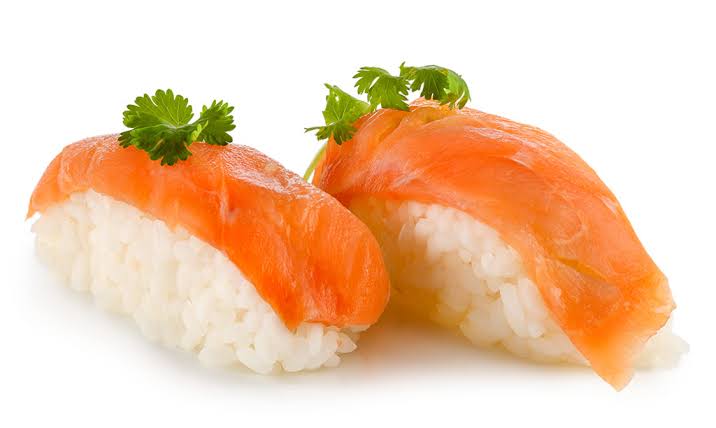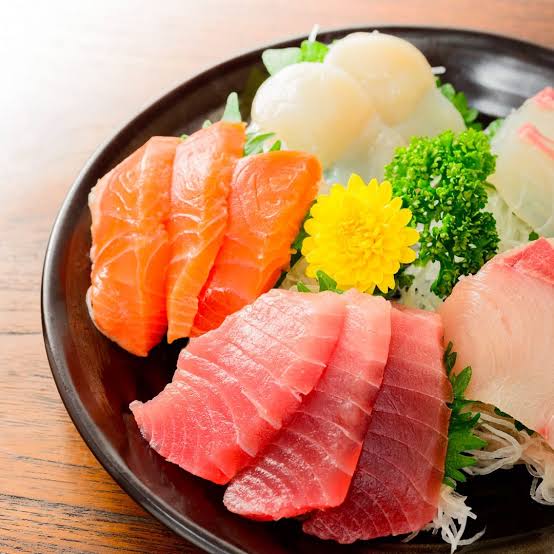What Is Nigiri?
The word Nigiri comes from Japanese verb ‘’Nigiru’’ which means ‘’ to grip or to grasp’’. This Japanese dish is prepared with vinegared rice and thin slices of fish. The rice balls are molded into various shapes by hand and garnished or pickled with different condiments and ingredients. Then it is compressed with two fingers to form a base. A thin slice of fish is placed atop the molded rice base with green vegetable toppings.
Favorite seafood and fish used in preparing Nigiri include: Tuna, Salmon, yellowtail, shrimp, octopus, shrimp, crab, freshwater ell, herring roe, egg omelet, squid, salmon roe and abalone. Nigiri is a combination of both sushi and sashimi, but it does not include any red meat. It common in the Menu at all places you get Sushi. Nigiri is served with or without garnishing. The different ingredients for topping Nigiri are tuna mayo, pickled plums, bonito flakes, teriyaki chicken, soy sauce, pickled ginger, wasabi and pickles. Nigiri

What You Need To Know About Nigiri
- The word Nigiri comes from Japanese verb ‘’Nigiru’’ which means ‘’ to grip or to grasp’’.
- Nigiri is raw seafood that consists of thin slices of raw fish topped over small balls of vinegared rice.
- Original Nigiri does not include any extra ingredients like cucumbers or avocado. Though this days Avocado and Omelette are frequently being used for Nigiri.
- Nigiri is often eaten raw, but some of the fish are seared, grilled or boiled.
- This Japanese dish is prepared with vinegared rice and thin slices of sea food.
- Nigiri is a type of Sushi.
- Favorite seafood and fish used in preparing Nigiri include: Tuna, Salmon, yellowtail, shrimp, octopus, shrimp, crab, freshwater ell, herring roe, egg omelet, squid, salmon roe and abalone.
- Nigiri is a combination of both sushi and sashimi, but it does not include any red meat.
- Nigiri is served with or without garnishing. The different ingredients for topping Nigiri are tuna mayo, pickled plums, bonito flakes, teriyaki chicken, soy sauce, pickled ginger, wasabi and pickles.
- Nigiri is served with rice on wooden trays and therefore it can be eaten by hands or by use of chopsticks.
- Nigiri is served on the dining table in pairs. It is sometimes covered with seaweed (nori sheet), but some other Nigiri is served without the nori sheet. It is pickled with only salt or seasoning like sesame seeds.
- The quality and taste of the Nigiri depends on the freshness and type of the Fish used in preparing it. Salmon or Tuna giri are the best options to try, if indeed you are eating it for the first time.
What Is Sashimi?
The word Sashimi in Japanese in Japanese means punctured flesh or meat. The term may have originated from the culinary practice of sticking the fish’s tail and fin to the slices in identifying the fish being eaten. Sashimi is a Japanese dish of only thin slices of raw fish, poultry or meat. Sashimi does not include vinegared rice and this makes it different from Sushi, though It can also be ordered as a topping or filling in Sushi.
Favorite seafood or fish for Sashimi include: Tuna, Salmon, red snapper, yellowfin tuna, scallop, sea urchin mackerel, Octopus, frog etc. The quality and taste of the Sashimi depends on the freshness and type of the Fish used in preparing it. Salmon or Tuna giri are the best options to try, if indeed you are eating it for the first time. There are different ways in which Sashimi is garnished. The popular toppings are toasted nori, shredded salon radish, shiso leaves, wasabi, pickled ginger, daiko radish or any sauce.

What You Need To Know About Sashimi
- Sashimi is a Japanese term for punctured/pierced flesh or meat (Sashi means pierced whereas mi means flesh).
- Sashimi is a dish with thinly sliced raw fish (sea food) and it is served without rice.
- Sashimi is usually served thinly sliced on a bed of daikon, sans rice.
- Favorite seafood or fish for Sashimi include: Tuna, Salmon, red snapper, yellowfin tuna, scallop, sea urchin mackerel, Octopus, frog etc.
- Chicken, turkey, beef, horse meat can also be used for Sashimi.
- Sashimi is not considered a type of Sushi. It can also be ordered as a topping or filling in Sushi.
- Sashimi does not require any form of heat and is eaten raw. It is sliced with precision, well garnished and then served.
- There are different ways in which Sashimi is garnished. The popular toppings are toasted nori, shredded salon radish, shiso leaves, wasabi, pickled ginger, daiko radish or any sauce.
- Sashimi is best served as an appetizer. It comes before the main dish.
- Generally served without rice and is eaten with the use of chopsticks.
- The quality and taste of the Sashimi depends on the freshness and type of the Fish used in preparing it. Salmon or Tuna giri are the best options to try, if indeed you are eating it for the first time.
- The nutritional value of Sashimi varies based on the type of fish used and how it is garnished.
Also Read: Difference Between Chow Mein And Lo Mein
Difference Between Nigiri And Sashimi In Tabular Form
| BASIS OF COMPARISON | NIGIRI | SASHIMI |
| Etymology | The word Nigiri comes from Japanese verb ‘’Nigiru’’ which means ‘’ to grip or to grasp’’. | Sashimi is a Japanese term for Punctured flesh (Sashi means pierced whereas mi means flesh). |
| Description | Nigiri is raw seafood that consists of thin slices of raw fish topped over small balls of vinegared rice. | Sashimi is a dish with thinly sliced raw fish (sea food) and it is served without rice. |
| Extra Ingredients | Original Nigiri does not include any extra ingredients like cucumbers or avocado. Though this days Avocado and Omelette are frequently being used for Nigiri. | Sashimi may include any extra ingredients such as cucumber or Avocado. |
| Eating | Nigiri is often eaten raw, but some of the fish are seared, grilled or boiled. | Sashimi does not require any form of heat and is eaten raw. It is sliced with precision, well garnished and then served. |
| Preparation | This Japanese dish is prepared with vinegared rice and thin slices of sea food. | This dish is prepared with thin slices of sea food and other ingredients but served without rice. |
| Nature | Nigiri is a type of Sushi. | Sashimi is not considered a type of Sushi. It can also be ordered as a topping or filling in Sushi. |
| Favorite | Tuna, Salmon, yellowtail, shrimp, octopus, shrimp, crab, freshwater ell, herring roe, egg omelet, squid, salmon roe and abalone. | Tuna, Salmon, red snapper, yellowfin tuna, scallop, sea urchin mackerel, Octopus, frog etc. |
| Red Meat | Nigiri is a combination of both sushi and sashimi, but it does not include any red meat. | Chicken, turkey, beef, horse meat can also be used for Sashimi. |
| Garnishing | Nigiri is served with or without garnishing. | Sashimi is always garnished. |
| Toppings | Tuna mayo, pickled plums, bonito flakes, teriyaki chicken, soy sauce, pickled ginger, wasabi and pickles. | Toasted nori, shredded salon radish, shiso leaves, wasabi, pickled ginger, daiko radish or any sauce. |
| Chopsticks | Nigiri is served with rice on wooden trays and therefore it can be eaten by hands or by use of chopsticks. | Generally served without rice and is eaten with the use of chopsticks. |
| Served With | Nigiri is served on the dining table in pairs. It is sometimes covered with seaweed (nori sheet). | Sashimi is usually served thinly sliced on a bed of daikon, sans rice. |
| Quality & Taste | The quality and taste of the Nigiri depends on the freshness and type of the Fish used in preparing it. | The quality and taste of the Sashimi depends on the freshness and type of the Fish used in preparing it. |
Also Read: Difference Between Roll Sushi And Hand Roll Sushi